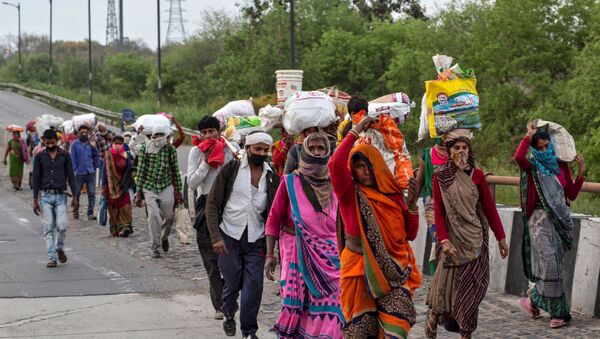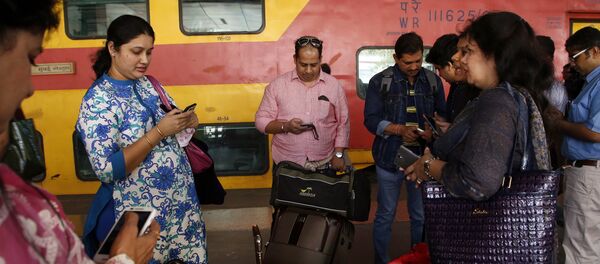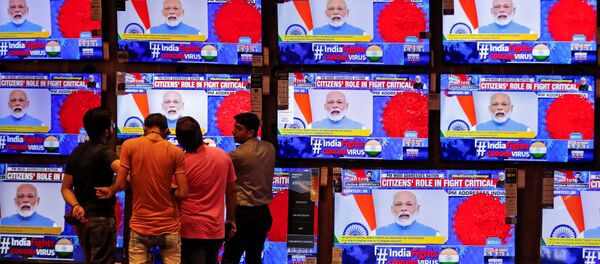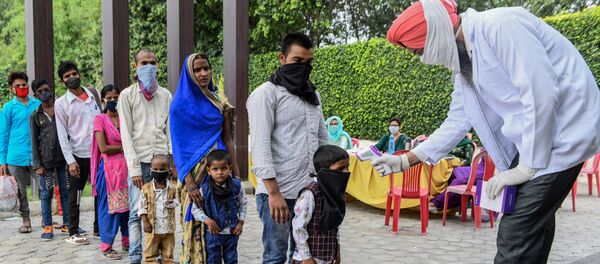After ensuring strict compliance with a national lockdown for over two months as an anti-COVID-19 pandemic measure, Indian Prime Minister Narendra Modi's government is now gradually opening up various sectors of the economy amid a mass exodus of migrants from the nation's urban centres to their rural hometowns.
Since its launch on 25 March, the lockdown has caused shuttering of nearly all industrial and economic activity across the country, affecting the livelihoods of millions of people linked to it. The measure has also prompted a tectonic shift in labour demography.
Feeling left to fend for themselves and with no source of income, tens of thousands of migrant labourers set off on foot towards their hometowns, often hundreds of kilometres away in low-income agricultural communities. All were anxious to amid the sudden uncertainty generated by the pandemic and the government's response.
As the exodus from industrial cities still continues, India's central and state government are now facilitating the workers' safe return home. The move came as news emerged that many of the migrants were reportedly dying of hunger, exhaustion or due to road accidents, causing public outrage.
The chartered trains project was led by Piyush Goyal, a prominent minister in Prime Minister Modi's cabinet; there are now plans to double the number of daily trains for labourers from 200 to 400.
Meanwhile, given the mass exodus prompted by the pandemic, some analysts believe reviving India's economic activity may remain a daunting challenge due to a shortage of labour, as the return of the entire migrant workforce is unlikely to happen any time soon.
A host of analysts Sputnik has spoken with believe that reverse migration will have macroeconomic spillovers as it's inevitable that many won't return, impacting businesses and industry. They fear it may also cause massive disruptions to the urban and rural economy, impacting the society and healthcare system, as well as corporate business models.
He, however, believes that even though the pandemic and the lockdown have "impacted the economy badly", the lack of available workers will not have a significant impact now, as demand has dried up in the Indian economy.
"Since the demand is also down, the non-availability of labourers is not that big a worry. Industry is not going to start soon and labourers are also scared right now. They will come back only when they are hopeful of getting jobs and fear of the virus abates," says Sood.
Observers of the Indian trade sector, however, seem unanimous in opining that all the migrant labourers will not return soon and the shift in the labour demography of the country in the post-COVID era will have its own ramifications and disruptions.
"Tourism, hospitality, industry and construction will face the loss of labour capital. We are going to suffer for the next six months," says social observer Prof. Irudaya Rajan from the Centre for Development Studies.
A prominent voice among Delhi’s traders, Pravin Khandelwal, President of the Confederation of All India Traders, said: "The labour that has gone will not come back easily."
Manipadma Datta, Vice Chancellor of the TERI School of Advanced Studies also agrees that after being forced to face the drudgery of walking miles on foot to their homes amid high summer temperatures with their belongings and children and elderly, India's labour force is "traumatised" and has not been treated in a "deserving way".
Sood, from the India’s industry chamber Assocham, believes every crisis presents opportunities but that there will also be disruptions. He believes fortune will favour "anyone who will be able to ramp up, that will be able to establish a business model conducive to the new world order."
He says the pandemic presents lucrative prospects for automation. "No touch and no physical contact is a challenge but it also opens up new opportunities. The opportunity lies in home, office automation."
He believes new innovations could take root, including “conveyor-based food delivery in restaurants, advanced robotics, voice command on computers rather than the use of keys, the automation of doors, and artificial intelligence-based contactless apparel retail wherein software matches the clothes with body type for contactless purchase."
As for the rural economy, Prof. Datta of the TERI School of Advanced Studies contends agriculture may be the fall back option for migrants but they run the risk of being unproductively employed.
“While the industries in the big cities will suffer due to a shortage of labour, the migrants, back home, will try to survive on agriculture. In rural areas, people either have land or they become agricultural labourers. A limited number of people are needed to till the land. If additional people join, they remain underemployed,” he adds.
According to the 2011 Census of India, there were 500 million migrants, 30 percent (150 million) of whom migrate within the Indian states for work.
Khandelwal says 3 million labourers were employed with Delhi traders in some of the busy local markets like Chandni Chowk and Chawri Bazar in Old Delhi alone.
“In the wake of the pandemic, almost 80 percent of the labour force employed with traders has moved (back to their) villages. The majority of those remaining are all set to go as well. We are left with only local labourers. This will jeopardise businesses in near future,” he said, while accusing the central and state governments of having “failed miserably” to take care of the labour force amid the pandemic.







